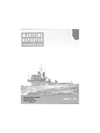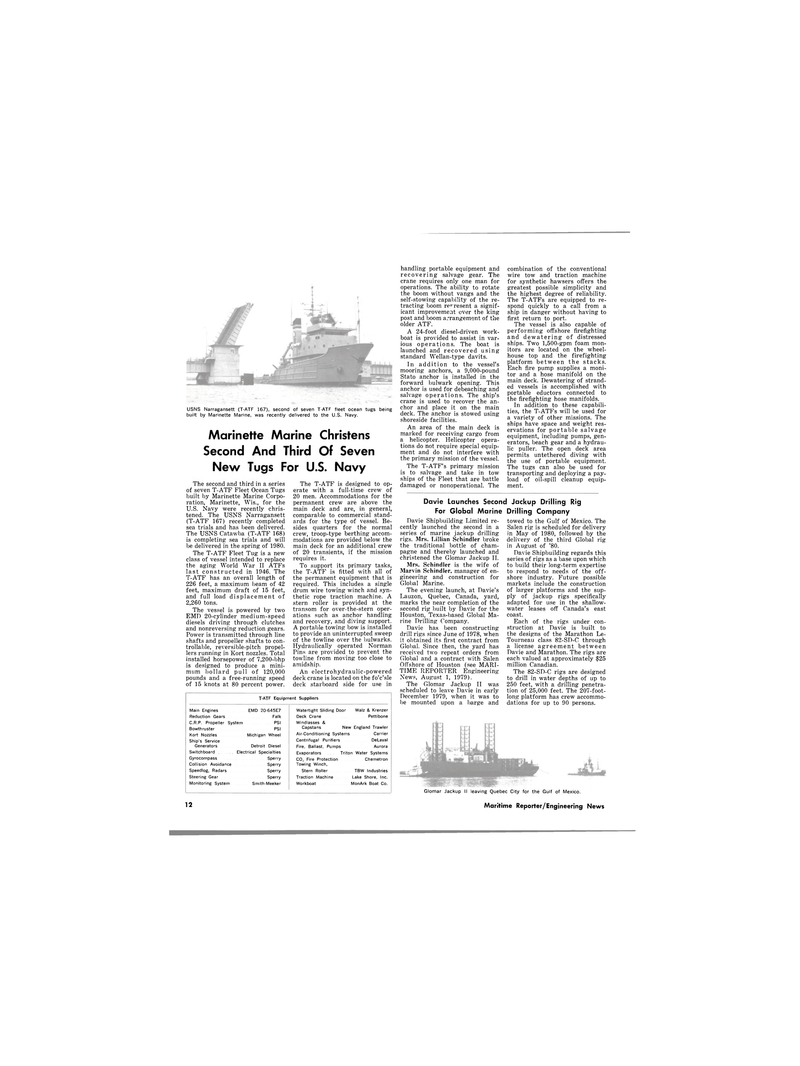
Page 8: of Maritime Reporter Magazine (January 1980)
Read this page in Pdf, Flash or Html5 edition of January 1980 Maritime Reporter Magazine
USNS Narragansett (T-ATF 167), second of seven T-ATF fleet ocean tugs being built by Marinette Marine, was recently delivered to the U.S. Navy.
Marinette Marine Christens
Second And Third Of Seven
New Tugs For U.S. Navy
The second and third in a series of seven T-ATF Fleet Ocean Tugs built by Marinette Marine Corpo- ration, Marinette, Wis., for the
U.S. Navy were recently chris- tened. The USNS Narragansett (T-ATF 167) recently completed sea trials and has been delivered.
The USNS Catawba (T-ATF 168) is completing sea trials and will be delivered in the spring of 1980.
The T-ATF Fleet Tug is a new class of vessel intended to replace the aging World War II ATFs last constructed in 1946. The
T-ATF has an overall length of 226 feet, a maximum beam of 42 feet, maximum draft of 15 feet, and full load displacement of 2,260 tons.
The vessel is powered by two
EMD 20-cylinder medium-speed diesels driving through clutches and nonreversing reduction gears.
Power is transmitted through line shafts and propeller shafts to con- trollable, reversible-pitch propel- lers running in Kort nozzles. Total installed horsepower of 7,200-bhp is designed to produce a mini- mum bollard pull of 120,000 pounds and a free-running speed of 15 knots at 80 percent power.
The T-ATF is designed to op- erate with a full-time crew of 20 men. Accommodations for the permanent crew are above the main deck and are, in general, comparable to commercial stand- ards for the type of vessel. Be- sides quarters for the normal crew, troop-type berthing accom- modations are provided below the main deck for an additional crew of 20 transients, if the mission requires it.
To support its primary tasks, the T-ATF is fitted with all of the permanent equipment that is required. This includes a single drum wire towing winch and syn- thetic rope traction machine. A stern roller is provided at the transom for over-the-stern oper- ations such as anchor handling and recovery, and diving support.
A portable towing bow is installed to provide an uninterrupted sweep of the towline over the bulwarks.
Hydraulically operated Norman
Pins are provided to prevent the towline from moving too close to amidship.
An electrohydraulie-powered deck crane is located on the fo'c'sle deck starboard side for use in handling portable equipment and recovering salvage gear. The crane requires only one man for operations. The ability to rotate the boom without vangs and the self-stowing capability of the re- tracting boom represent a signif- icant improvement over the king post and boom arrangement of the older ATF.
A 24-foot diesel-driven work- boat is provided to assist in var- ious operations. The boat is launched and recovered using standard Wellan-type davits.
In addition to the vessel's mooring anchors, a 9,000-pound
Stato anchor is installed in the forward bulwark opening. This anchor is used for debeaching and salvage operations. The ship's crane is used to recover the an- chor and place it on the main deck. The anchor is stowed using shoreside facilities.
An area of the main deck is marked for receiving cargo from a helicopter. Helicopter opera- tions do not require special equip- ment and do not interfere with the primary mission of the vessel.
The T-ATF's primary mission is to salvage and take in tow ships of the Fleet that are battle damaged or nonoperational. The combination of the conventional wire tow and traction machine for synthetic hawsers offers the greatest possible simplicity and the highest degree of reliability.
The T-ATFs are equipped to re- spond quickly to a call from a ship in danger without having to first return to port.
The vessel is also capable of performing offshore firefighting and dewatering of distressed ships. Two 1,500-gpm foam mon- itors are located on the wheel- house top and the firefighting platform between the stacks.
Each fire pump supplies a moni- tor and a hose manifold on the main deck. Dewatering of strand- ed vessels is accomplished with portable eductors connected to the firefighting hose manifolds.
In addition to these capabili- ties, the T-ATFs will be used for a variety of other missions. The ships have space and weight res- ervations for portable salvage equipment, including pumps, gen- erators, beach gear and a hydrau- lic puller. The open deck area permits untethered diving with the use of portable equipment.
The tugs can also be used for transporting and deploying a pay- load of oil-spill cleanup equip- ment.
Davie Launches Second Jackup Drilling Rig
For Global Marine Drilling Company
T-ATF Equipment Suppliers
Main Engines EMD 20-645E7 Watertight Sliding Door Walz & Krenzer
Reduction Gears Falk Deck Crane Petti bone
C.R.P. Propeller System PSI Windlasses &
Bowthruster PSI Capstans New England Trawler
Kort Nozzles Michigan Wheel Air-Conditioning Systems Carrier
Ship's Service Centrifugal Purifiers DeLaval
Generators Detroit Diesel Fire, Ballast, Pumps Aurora
Switchboard Electrical Specialties Evaporators Triton Water Systems
Gyrocompass Sperry COL. Fire Protection Chemetron
Collision Avoidance Sperry Towing Winch,
Speedlog, Radars Sperry Stern Roller TBW Industries
Steering Gear Sperry Traction Machine Lake Shore, Inc.
Monitoring System Smith-Meeker Workboat MonArk Boat Co.
Davie Shipbuilding Limited re- cently launched the second in a series of marine jackup drilling rigs. Mrs. Lillian Schindler broke the traditional bottle of cham- pagne and thereby launched and christened the Glomar Jackup II.
Mrs. Schindler is the wife of
Marvin Schindler. manager of en- gineering and construction for
Global Marine.
The evening launch, at Davie's
Lauzon, Quebec, Canada, yard, marks the near completion of the second rig built by Davie for the
Houston, Texas-based Global Ma- rine Drilling Company.
Davie has been constructing drill rigs since June of 1978, when it obtained its first contract from
Global. Since then, the yard has received two repeat orders from
Global and a contract with Salen
Offshore of Houston (see MARI-
TIME REPORTER Engineering
News, August 1, 1979).
The Glomar Jackup II was scheduled to leave Davie in early
December 1979, when it was to be mounted upon a barge and towed to the Gulf of Mexico. The
Salen rig is scheduled for delivery in May of 1980, followed by the delivery of the third Global rig in August of '80.
Davie Shipbuilding regards this series of rigs as a base upon which to build their long-term expertise to respond to needs of the off- shore industry. Future possible markets include the construction of larger platforms and the sup- ply of jackup rigs specifically adapted for use in the shallow- water leases off Canada's east coast.
Each of the rigs under con- struction at Davie is built to the designs of the Marathon Le-
Tourneau class 82-SD-C through a license agreement between
Davie and Marathon. The rigs are each valued at approximately $25 million Canadian.
The 82-SD-C rigs are designed to drill in water depths of up to 250 feet, with a drilling penetra- tion of 25,000 feet. The 207-foot- long platform has crew accommo- dations for up to 90 persons.
Glomar Jackup II leaving Quebec City for the Gulf of Mexico. 12 ZIDELL Maritime Reporter/Engineering News

 7
7

 9
9
